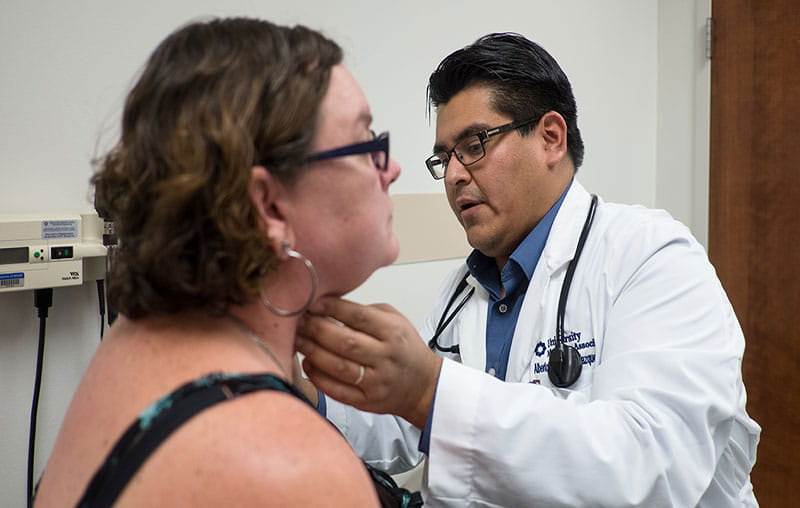If you have little kids in the home, it might seem like bandages are always on your shopping list. Toddlers and other small children are masters in the art of bumps and bruises.
Most of the time, those childhood injuries are minor and easily handled at home, often with the help of a fun bandage. But how can you know when it’s time to seek medical attention?
Dr. Sarah Gross, a pediatrician with University Health, is shedding light on this topic to help all parents and caregivers.
Common Childhood Injuries
If you’ve ever wondered how it’s possible for your little ones to have a new scrape or bump so often, just consider how they get around. While adults slowly make their way from one room to the next, children are much more likely to take off running.
Skipping and jumping are also a regular part of the rotation. “Nothing about childhood is done in slow motion, which means kids are at a higher risk of bumping into furniture, walls and other objects,” says Dr. Gross.
Common injuries in kids include:
- Broken bones
- Bruises
- Eye injuries
- Head injuries
- Mouth or tooth injuries
- Nosebleeds
- Scrapes and cuts
- Strains and sprains
Many of these childhood injuries can be treated with some basic at-home care. For example, kids will usually declare bruises “all better” after a few minutes with an ice pack on the affected area. Adding a popsicle for good measure can’t hurt the healing process.
Scrapes
Scrapes and other cuts can be treated by applying pressure if the cut is still bleeding. Once it’s stopped bleeding, wash the wound carefully with plain water and a gentle soap, then apply a bandage to keep debris out as it heals.
Nosebleeds
You can stop a nosebleed by having your child sit or stand and slightly lean forward. Firmly pinch the soft part of the nose and hold with gentle pressure for 10 minutes.
Sprains
Sprains and strains are common sports and playground injuries. When they’re minor and only causing a small amount of pain, you may be able to treat them using the acronym “RICE.”
R - Resting
I - Icing
C - Compressing
E - Elevating the injury
When to Call Your Child’s PCP
While many injuries in kids can be treated at home, there are some cases where medical attention is needed. That may be a same day visit in your pediatrician’s office or a visit to a pediatric urgent care, like our PediExpress.
“Your pediatrician’s office can help guide you on the next best step based on your child’s symptoms, availability and time of day,” Dr. Gross explains.
Reasons to call your pediatrician’s office include any head injury, since a bonk to the head can lead to a concussion or even a skull fracture.
Other reasons to call your child’s primary care provider (PCP) include:
- An inability to walk on a limb or put weight on it
- Cuts with rough edges or that are long and deep
- Deformity
- Numbness around the injury
- Reluctance to use the body part
- Significant pain
- Signs of infection, such as redness, discoloration, pus or swelling
- Vision changes
- Weakened pulse around the injury
- Wounds that won’t stop bleeding
Sports-related injuries or accidents that can be best addressed in an urgent care setting include anything requiring procedures like stitches, urgent imaging (like an x-ray) for deformity or neurovascular changes (numbness or weakened pulses around an injury).
If you’re ever in doubt — rely on your pediatrician’s office to help you with the next steps.
When a Childhood Injury Is an Emergency
Certain injuries in kids merit skipping the PCP’s office and instead seeking immediate medical attention. The National Library of Medicine recommends calling 911 or going to the emergency room if your child has:
- An injury to the neck or spine
- Bone protruding through the skin
- Cold or pale skin near an injury
- Deep wound
- Difficulty breathing
- Head injury accompanied by passing out, throwing up, sleepiness or behavior changes
- Loss of consciousness
- Loss of limb movement
- Rapid heartbeat
- Uncontrollable bleeding
- Worsening pain
While it’s not a life-threatening emergency, an injury to a child’s permanent tooth is a dental emergency. If your child’s tooth is knocked out, rinse it with salt water or warm milk, then reimplant it in the gums within a few minutes and hold it there.
If you aren’t able to reinsert the tooth, keep it moist. You can do so by placing it in a cup with enough milk to cover it or even a small amount of your child’s saliva. After that, call the dentist’s office to find out what to do next.
Children’s Primary Care at University Health
Your child’s pediatrician can be your go-to resource for questions about childhood injuries and other topics, like immunizations and other health screenings.
Need a primary care provider for your child? You can find a pediatrician at University Health and schedule an appointment today.
If you can’t make it into a pediatrician’s office, learn more about our mobile family health clinics and health centers.
University Health is home to the only Level I adult and pediatric trauma center in South Texas. Call 911 for immediate help.





